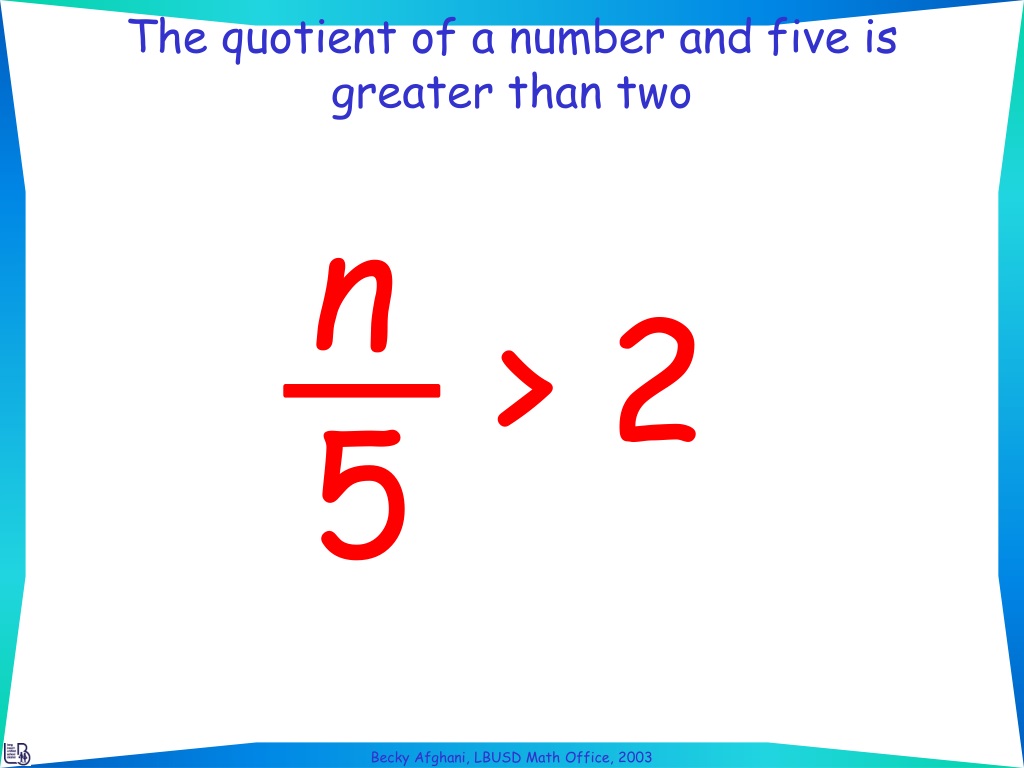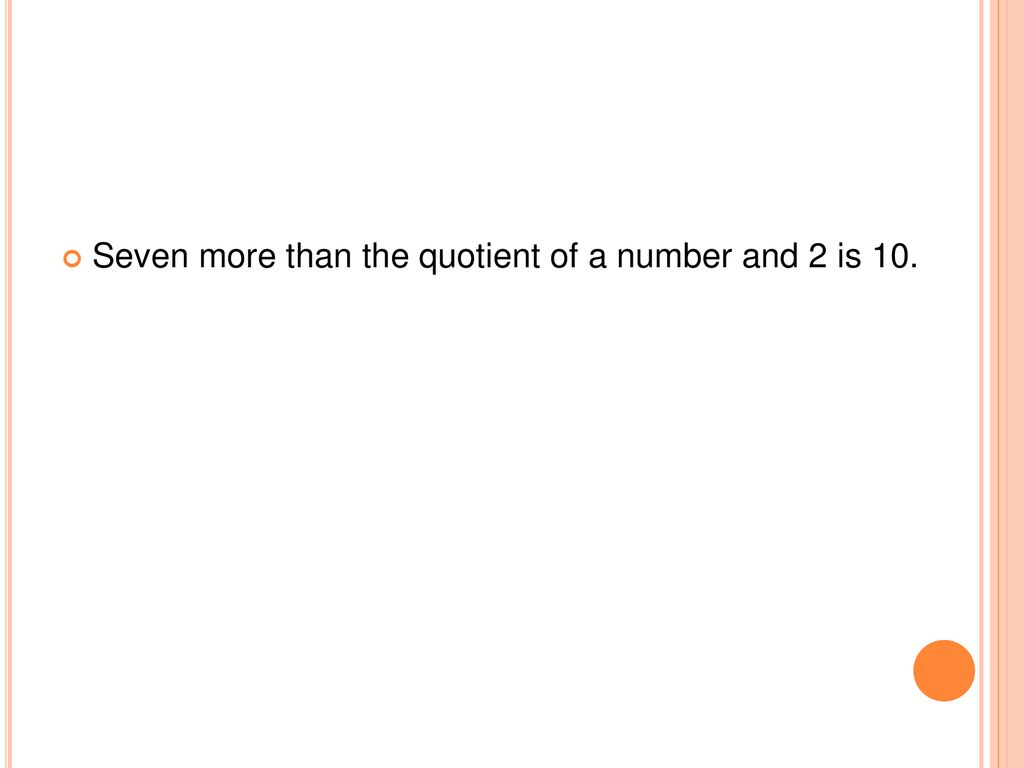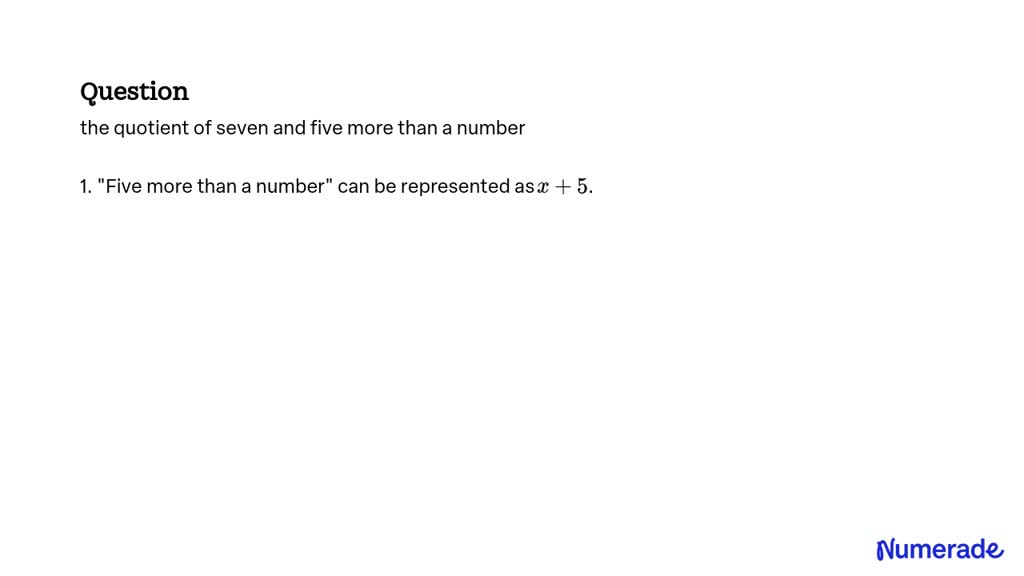2 More Than The Quotient Of A Number And 5

Imagine a world where numbers dance to the rhythm of logic, where equations whisper secrets of balance and possibility. A world where the seemingly abstract realm of mathematics gently shapes our everyday understanding.
In this intricate dance, one particular expression has recently captured the attention of educators and students alike: "2 more than the quotient of a number and 5." While it might sound like a complex riddle, this seemingly simple phrase holds a powerful key to unlocking algebraic thinking and problem-solving skills.
The expression represents a fundamental concept in mathematics: the translation of verbal phrases into algebraic expressions. This ability is crucial for students as they progress through their mathematical journey, forming the bedrock for tackling more advanced concepts such as equation solving, function analysis, and mathematical modeling.
Unpacking the Expression: A Step-by-Step Guide
Let's dissect "2 more than the quotient of a number and 5" to fully appreciate its meaning. First, we need to define our unknown: "a number." In algebra, we often represent this with a variable, typically x or n.
Let's use x. The phrase "the quotient of a number and 5" means we're dividing x by 5. This is written as x/5.
Finally, "2 more than" indicates addition. So, we add 2 to the quotient, giving us the complete algebraic expression: x/5 + 2.
Why This Matters: Building Blocks of Algebra
The significance of this expression extends far beyond a single problem in a textbook. It represents a crucial step in the development of algebraic reasoning.
Translating verbal phrases into algebraic expressions is a core skill assessed in standardized mathematics tests across the nation, including those designed by organizations like the National Assessment of Educational Progress (NAEP).
Dr. Emily Carter, a mathematics education specialist at the Center for Research in Mathematics and Science Education, explains, "This skill bridges the gap between concrete arithmetic and the more abstract world of algebra. Students who master this translation are better equipped to understand and manipulate equations."
According to research from the National Council of Teachers of Mathematics (NCTM), a focus on algebraic thinking from an early age can significantly improve a student's overall mathematical proficiency. This translates to greater success in later math courses and improved problem-solving abilities in various fields.
The NCTM emphasizes the importance of providing students with opportunities to practice translating real-world scenarios into mathematical expressions and equations. This helps them develop a deeper understanding of the underlying concepts and their applications.
Real-World Connections: Finding Math in Everyday Life
While the expression might seem abstract, it can be easily connected to real-world scenarios. Imagine you're sharing a pizza with 5 friends, and then decide to order 2 more slices for yourself.
If x is the total number of pizza slices, then x/5 represents the number of slices each friend initially receives. Adding 2 accounts for the extra slices you get.
Another example: You have a certain amount of money (x) and decide to divide it equally among 5 charities. Afterward, you donate an additional $2 to your favorite charity.
Teaching Strategies: Making Algebra Accessible
Teachers are employing various strategies to help students master the translation of verbal phrases. One popular method involves using visual aids and manipulatives.
Representing the unknown number with counters or blocks can make the concept more concrete, especially for younger learners. Another effective approach is to encourage students to explain their reasoning aloud.
Asking students to verbalize the steps they are taking to translate a phrase helps them solidify their understanding and identify any potential misconceptions. Interactive whiteboard activities and online simulations are also proving to be valuable tools for engaging students and reinforcing the concepts.
Mrs. Rodriguez, a middle school math teacher with 15 years of experience, shares, "I've found that breaking down the phrases into smaller, manageable chunks helps students immensely. We focus on identifying the key operations and the order in which they need to be performed. It's like solving a puzzle, one piece at a time."
Using collaborative activities, where students work together to translate different phrases, is another engaging method that fosters teamwork and peer learning. Games and competitions can also be used to motivate students and make learning fun.
Challenges and Misconceptions: Addressing Common Pitfalls
Despite the efforts to make algebra accessible, students often encounter challenges when translating verbal phrases. One common mistake is misinterpreting the order of operations.
For example, students might incorrectly write "2 more than the quotient of a number and 5" as (x + 2)/5, instead of x/5 + 2. Another challenge is understanding the meaning of different keywords.
Words like "less than" and "decreased by" can be particularly confusing. Teachers are addressing these misconceptions by providing students with ample practice and explicit instruction on the meaning of key vocabulary.
Open Educational Resources (OER) are increasingly being used to provide students with access to high-quality learning materials and practice problems. These resources often include interactive exercises and video tutorials that can help students overcome their challenges.
Looking Ahead: Building a Strong Foundation for Future Success
Mastering the translation of verbal phrases into algebraic expressions is not just about passing a test. It is about building a strong foundation for future success in mathematics and beyond.
This skill empowers students to think critically, solve problems effectively, and apply mathematical concepts to real-world situations. As students progress through their academic careers, they will encounter more complex mathematical models and equations.
The ability to translate these models into a form they can understand is essential for success in fields such as science, engineering, and finance. By focusing on algebraic thinking from an early age, we can help students develop the skills they need to thrive in a rapidly changing world.
So, the next time you encounter the phrase "2 more than the quotient of a number and 5," remember that it is more than just a mathematical expression. It is a gateway to unlocking the power of algebra and the endless possibilities of mathematical thinking.


![2 More Than The Quotient Of A Number And 5 [FREE] Translate the sentence into an equation. Two more than the](https://media.brainly.com/image/rs:fill/w:750/q:75/plain/https://us-static.z-dn.net/files/d8b/2e28dd4bba787baf6dc05454029d4099.png)

+Eight+less+than+the+quotient+of+a+number+and+two.jpg)












+5+more+than+y+apples+3.)+The+product+of+4+and+w.jpg)
